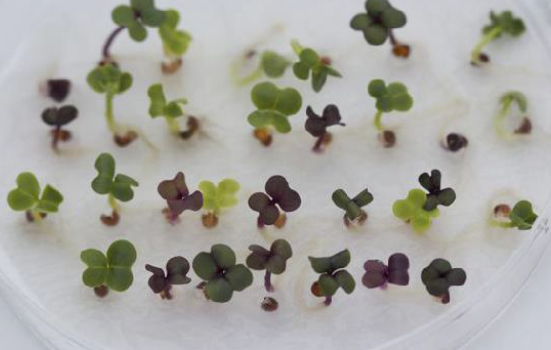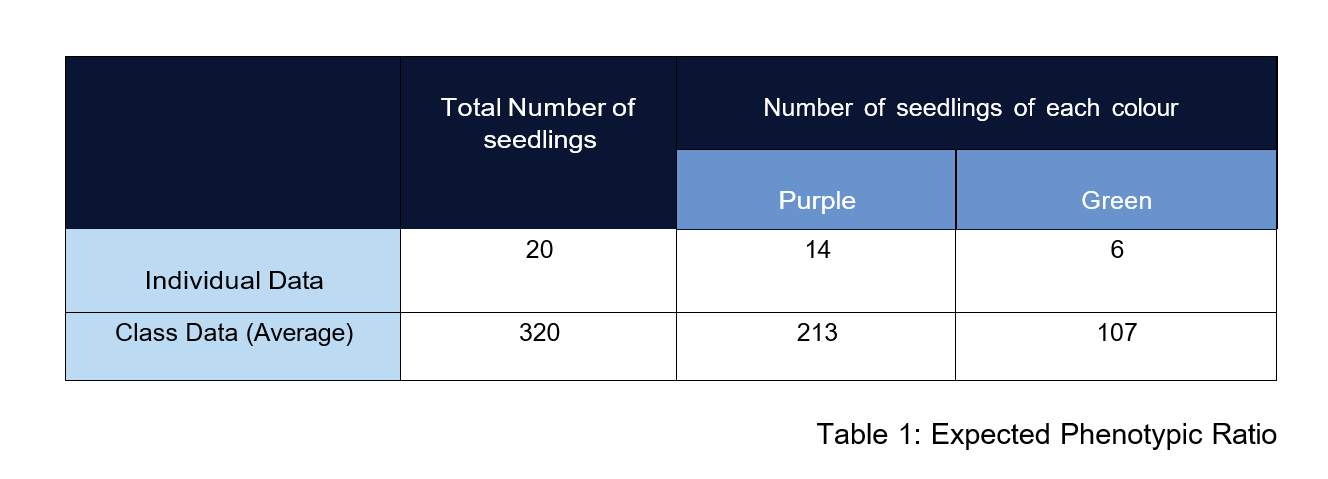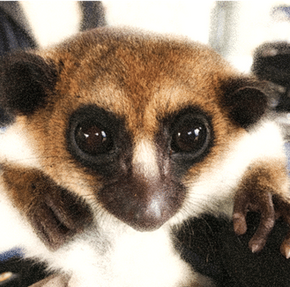Monohybrid Cross with Fast Plants (F2 Gen)
- Biology
- Classroom Practicals
- Genetics
- Year 11 & 12

AUSTRALIAN CURRICULUM ALIGNMENT:
- Frequencies of genotypes and phenotypes of offspring can be predicted using probability models, including Punnett squares, and by taking into consideration patterns of inheritance, including the effects of dominant, autosomal and sex-linked alleles and multiple alleles, and polygenic inheritance (ACSBL085)
BACKGROUND
Wisconsin Fast Plants are perfect for genetic studies as they are easily grown and allow students to clearly observe the variation of traits among siblings, parents and offspring, through the purple-stem trait. The plants are incredibly useful in illustrating characteristic variation among members of the same species, and how it occurs through genetic inheritance. Students are able to readily count the numbers of purple and non-purple stemmed seedlingsIn this investigation, students explore the mode of inheritance of a genetic trait in Wisconsin Fast Plants. In this monohybrid cross using Wisconsin Fast Plants, students observe how two alternative alleles from one gene control pigmentation in the stems of this plant. Students first predict the ratio of green and purple stems they expect to see using a Punnett square and then observe actual results in their seedlings. Students germinate the seeds by evenly spacing them over a wet filter paper disc in a petri dish.
After two weeks of regular watering and sunlight, students will be able to observe the seedling stem colours. Students then determine what the actual phenotypic ratio is, and whether their initial hypothesis was correct. Observations will show Wisconsin Fast Plant seedlings inherit two genes for this stem colour trait, one from each parent. The evidence will also show that there are two versions (alleles) of the gene for stem colour, and the purple allele is dominant, while the non-purple allele is recessive. This is an excellent opportunity for students to understand how different alleles result in different phenotypic traits in monohybrid cross. Students will gain valuable insight into how individuals of the same species and family can exhibit different characteristics.
PREPARATION- BY LAB TECHNICIAN
Preparations Workstations- Prepare a light source/s that will provide each student’s seeds with sufficient access to light. Seeds will need to be kept there for 3 days at a temperature of 19-24 °C.
-
Filter paper discs should fit inside the petri dish. If no, make filter paper discs for each student by cutting filter paper to fit inside the petri dish dimensions.
-
Provide each workstation with the following materials.
- Brassica rapa seeds, F2 non-purple stem
- Filter paper disc
- Large Petri dish
- Water Spray Dispenser
METHOD- STUDENT ACTIVITY
- Place a filter disc inside your Petri dish.
- Spray the filter disc with a water spray dispenser, until very damp.
- Arrange 20 seeds on the disc using forceps. The seeds should be spaced evenly approximately 1 cm apart.
- Spray more water over the seeds until they are dampened.
- Place the Petri dish with seeds on a bench at a temperature of 19-24 °C with sufficient access to sunlight.
- Add a few drops of water each day to ensure the paper remains moist. Be careful not to overwater; submerged seeds are unlikely to germinate.
- Predict the phenotypic ratio you expect to see using a Punnett square (monohybrid cross), where “P” represents purple pigment produced (dominant) and “p” represents green pigment produced (recessive).
- The seeds will germinate within 3 days. Small seedlings will enable you to identify purple and non-purple stem traits. Count the number of green and purple stems. Record your individual results, along with the class results in Table 1.

OBSERVATION AND RESULTS
Seeds will germinate within 3 days, with seedlings that clearly illustrate the purple/non-purple stem traits. After this time, students should observe a 3:1 ratio of purple stem and non-purple stem phenotypes in the F2 generation.
Below is an example of expected phenotypic ratio. Individual results will vary.

INVESTIGATION
- Ask students whether their predicted ratio based on your Punnett square was proven correct and whether there were any inconsistencies in the class results.
- Ask students to make careful observations on day 3 and analyse their data. Students can then make inferences about the genotypes based on the 3:1 segregation ratio of the purple stem and non-purple stem phenotypes in the F2 generation
 Time Requirements
Time Requirements
- 45 mins
 Material List
Material List
- Brassica rapa seeds (F2 non-purple stem, hairless)
- Filter paper disc
- Large Petri dish
- Water Spray Dispenser
- Forceps
- Water
- Light (24-hour fluorescent light source)
 Safety Requirements
Safety Requirements
-
Under no circumstances are the materials used in the practical to be consumed as food.
- Wash hands thoroughly before and after the practical or handling any organic materials.
- Wear appropriate personal protective equipment (PPE).


